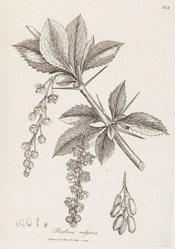
The plant for Fructidor 13 (August 30) is the barberry or berberis vulgaris. Mrs. Grieve says Berberis comes from the Arabic name for the fruit, and is derived from the word for a shell, referring to the glossiness of the leaves. It has yellow flowers and produces red berries. Grieve gives one common name for Barberry in England, where it is often used as a hedge plant, as the Pipperidge Bush, from 'pepon,' a pip, and 'rouge,' red, as descriptive of the scarlet, juiceless fruit. In Italy, it is sometimes called the Holy Thorn, because it was believed to be the plant used to make the Crown of Thorns.
There are many different species of barberry. See the article at Wikipedia for an amazing list:
http://en.wikipedia.org/wiki/Berberis
In the Northwest, we have several barberry plants, the most famous being the Oregon Grape (Mahonia (berberis) aquifolia). It has glossy leaves that look a lot like holly, yellow flowers in March and April and produces bluish-purple pseudo-grapes.
As usual, Mrs. Grieve has a wonderful, long description of the barberry, how it is grown and how it is used medicinally, including recipes for making barberry drops and tartlets:
http://www.botanical.com/botanical/mgmh/b/barcom12.html
It is the fruit, I think, that earned this plant this position in the French Republican calendar.. Mrs. Grieve says the fruits are used to make a candy that Rouen is famous for: confitures d'epine vinette. I found a recipe for this in my Larousse Gastronomique. It involves putting clusters of barberries (still attached to the stem) into boiling sugar water and cooking until bubbles appear. The pan is removed from the stove and when the fruit it beginning to cool, it is left to drain on a cloth in a hot cupboard. The following day, it is transferred to white paper to continue draining. Then dust the berries with confectioners sugar and let them dry some more.
Barberries are also made into jam, used to flavor meats, cooked into tartlets, and pickled with vinegar. Mrs. Grieve relates that Simon Paulli was cured of a malignant fever by drinking an infusion of the berries sweetened with sugar and syrup of roses. At his great wine-making site, Jack Keller provides a recipe for making barberry wine:
http://winemaking.jackkeller.net/barberry.asp
This page provides several recipes for making barberry jam:
http://earthnotes.tripod.com/barberry.htm
Larousse Gastronomique also mentions pickling the green berries like capers.
The leaves and bark are used medicinally. Michael Moore recommends using Oregon grape for three conditions: a bitter tonic for impaired salivary and gastric secretions, a stimulant for the liver, and, applied directly to the skin, as a disinfectant and antimicrobial.
Paghat, as usual, has a wonderful article on dealing with barberry in the garden, at least in her Northwest garden, plus some attractive photographs:
http://www.paghat.com/barberry.html
References:
Montagné, Prosper, The New Larousse Gastronomique, Crown 1960
Moore, Michael, Medicinal Plants of the Pacific West, Red Crane Books 1993
No comments:
Post a Comment